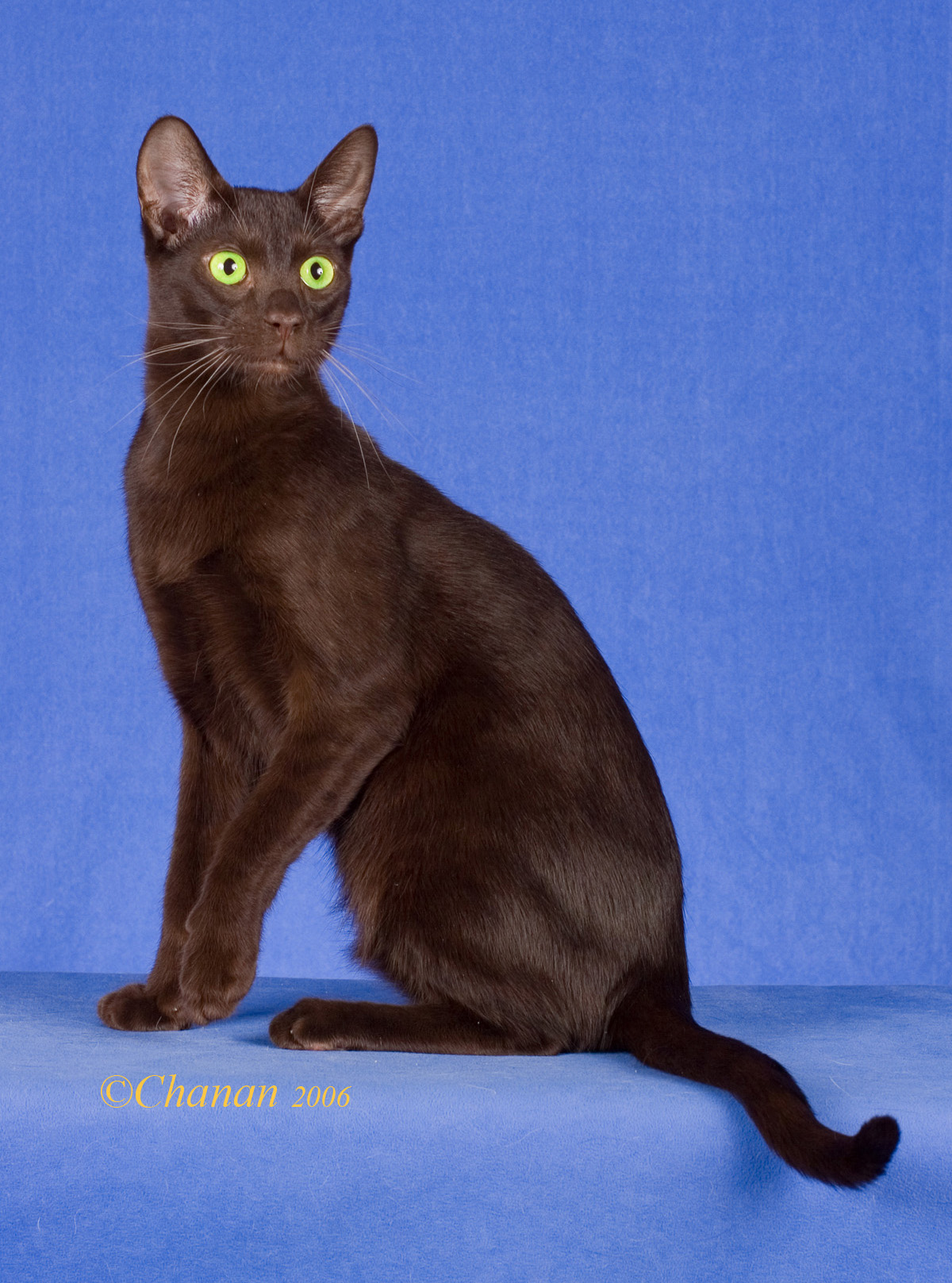
The Breed History
In Britain around the year 1951, a cross between a seal point
Siamese and a black part-Siamese shorthair cat produced a solid
brown offspring named Elmtower Bronze Idol, the first cat in
the GCCF registry for the breed. Brown colored cats had already
arrived from Europe much earlier (reported to be in the 1890s in a
London cat show; perhaps the oldest being Granny Grumps). These
chocolate solid foreign-type cats were called Chestnut Brown
Foreign for a while. At some point, Russian Blues were reported to
be introduced into the breed during outcrossing.
The name Havana may originate from the rabbit breed that has
the same coloring, or perhaps they are so-named because they
are brown like Havana cigars. The word brown was added to the
Havana name when the breed was imported to the USA in 1956.
American Havana Browns generally derive from one champion sire,
Quinn's Brown Satin of Sidlo.
Roofspringer Mahogany Quinn was the foundation female in
America, and Sildo's mother.
These cats were recognized first as the Chestnut Foreign Shorthair
by GCCF in 1958 and the name was changed to Havana in 1970. In
some registries, Havana is the preferred breed name since lilac color
is now also accepted.
In the CFA the Havana Brown (as it is now called in America)
was accepted for championship status in 1964. There is only very
limited outcrossing (pre-approval required) allowed in CFA and
none allowed in TICA. For a while (1974) CFA cut off outcrossing,
but breeders petitioned the organization to help them diversify the
gene pool in the late 1990s.
The British version, the Havana or Chestnut Brown Foreign cat is
more like a Chestnut Oriental Shorthair cat of CFA in breed standard
for conformation; the American cat is more moderate in build.
This is a very rare breed; in 1998, 1000 cats in total were registered,
with 130 in the breeding pool at only 12 active CFA catteries, and in
1997 only 36 cats were registered in the CFA.
As a note aside, Havana and Serval (African Wildcat) hybridization
has lead to a newer breed, Savannah.
Physical Characteristics
Weight: Females 6-8 lb (2.5-3.5 kg), males 8-10 lb (3.5-4.5 kg)
Coat: A rich shiny chocolate brown-mahogany color with no
markings; brown pigmentation also include the whiskers, nose
leather and pads. The coat is a medium short close lying coat. They
may have ghost tabby markings as kittens; with reddish highlights.
Note that TICA recognizes lilac colored cats also, but CFA does not.
Eyes: Oval eyes are medium in size, and are any shade of green with
a darker richer color preferred.
Points of Conformation: The head is long and there is a distinct
stop and distinct pinch behind the whisker pad, with a so-called
"corn-cob" or "hour glass" muzzle-this is a breed distinguishing
feature. Ears are large with rounded tips, tipping forward, and also
lightly haired and furnished. They possess a lithe medium length
body, medium size and length of neck, long legs, and a medium
thickness, tapering long tail. A foreign type, the Havana Brown is
not as tubular as Siamese or Oriental breed cats. Paws are small,
compact and oval shaped.
Grooming: Little grooming needed. Quick weekly brush with rubber
brush, chamois or soft cloth is fine.
Recognized Behavior Issues and Traits
Reported breed characteristics include: Very intelligent, affectionate,
need close human contact, playful, these high activity cats love to
jump up high, and are quiet voiced and very adaptable. Possessing a
dog-like personality, Havana Browns may be trained to fetch and be
leash trained. The Havana may bond closely with a favorite person.
They prefer a tranquil home, and sometimes can be a bit standoffish
towards people they do not know.
Caloric intake may need to be limited to prevent obesity.
Very low genetic diversity was found in a study carried out at the
University of California, Davis. Cats from 13 different catteries
and different breeds were assessed at multiple microsatellite DNA
markers. Final assessment was that this breed had one third of the
genetic diversity of random bred cats in this sample of 56 cats.
Havana and Korat were assigned moderate genetic diversity (0,53)
in this study.
Kitten Internet Information Project:
21 litters
83 kittens
3.9 kittens/litter
11% stillborn
24% C-sections
Average female birth weight 86 g, average male birth weight 95 g.
Drug Sensitivities
Nothing reported in the literature
Inherited Diseases
Hemophilia: Has been reported in this breed with low prevalence;
an X-linked recessive trait so males express the trait; only rarely
seen in females when homozygous for this recessive gene.
Disease Predispositions
Calcium Oxalate Urolithiasis: According to a case-control study5
it was reported that Havana Brown cats are at increased risk of
forming calcium oxalate uroliths.
Rare and Isolated Reports
Floppy Pinnae: Two clinically normal cats were presented for
sudden flop over of the ears in late maturity, bilateral; the distal
one third of the pinna was bent over, ear tips cool and devoid of
cartilage. There was a possibility that this condition may have been
secondary to prolonged use of glucocorticoid therapy for pruritic
ears resulting in iatrogenic hyperadrenocorticism.7 The etiology was
not conclusive. Compare with floppy pinnae in Siamese chapter.
Genetic Tests
If suspect hemophilia, run coagulation profile and specific factor
assays (Hemophilia A: Factor VIII, Hemophilia B: Factor IX).
Miscellaneous
- Breed name synonyms: Havana, Chestnut Brown Foreign Cat,
Swiss Mountain Cat (historical)
- Registries: TICA (as Havana--both lilac and brown colors
accepted), CFA, ACFA, GCCF (in Oriental, as Havana)
- Breed resources: Havana Brown Breed Council (CFA):
www.havanabrownbc.org
- Havana Brown Fanciers (CFA NW USA):
http://www.havanabrownfanciers.net/
- Havana and Oriental Lilac Cat Club (GCCF):
http://www.havanaandorientallilaccc.co.uk
Photo Gallery of Breed - Havana Brown Cat - Cat Breed
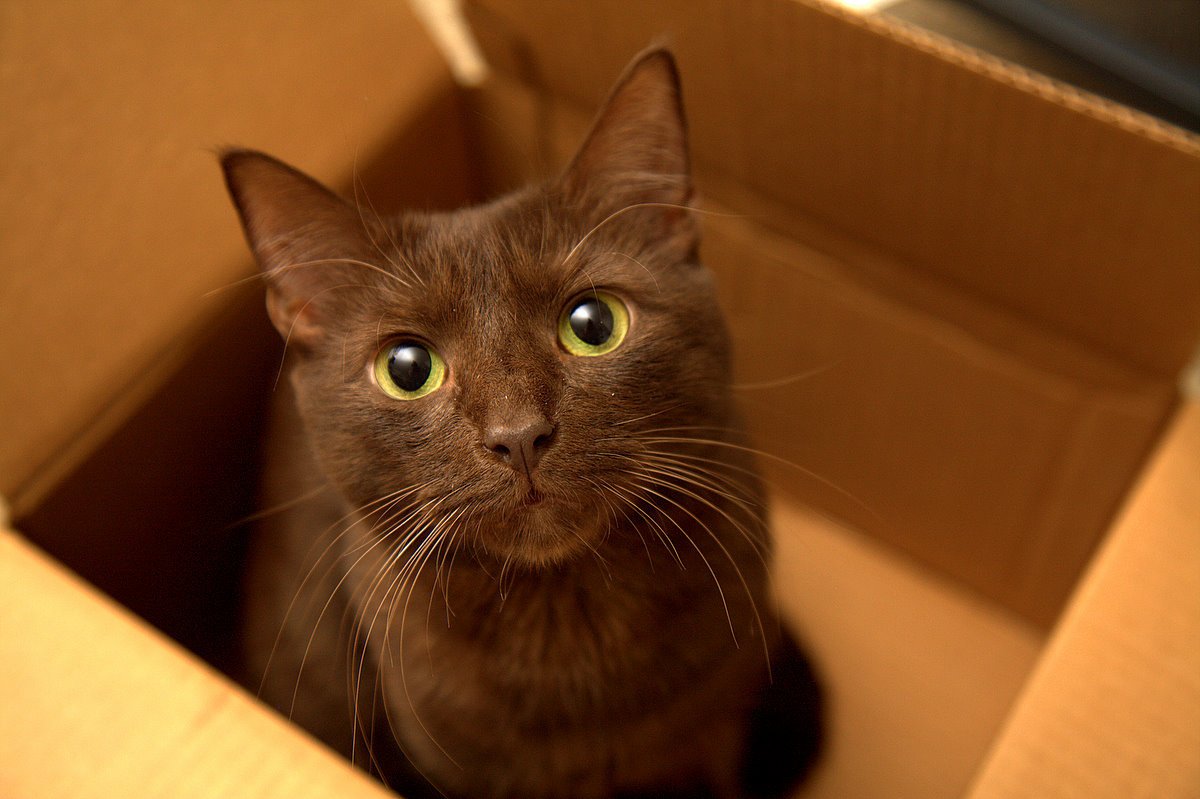


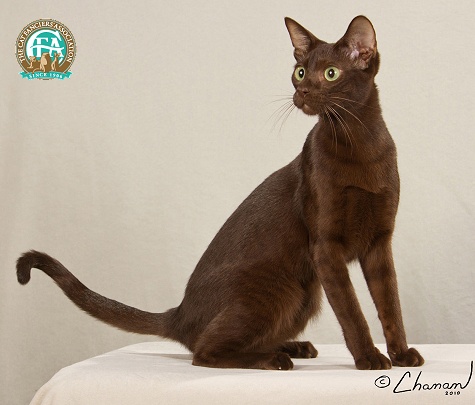
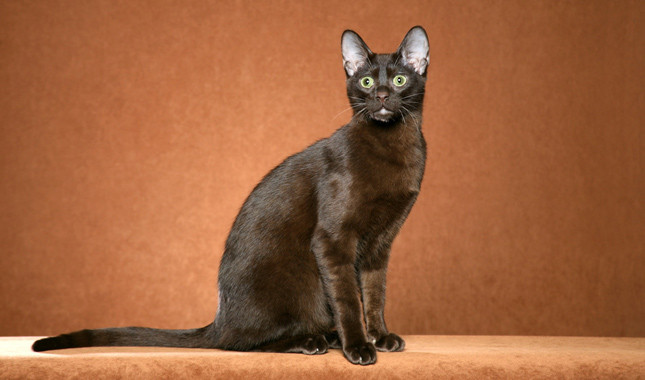
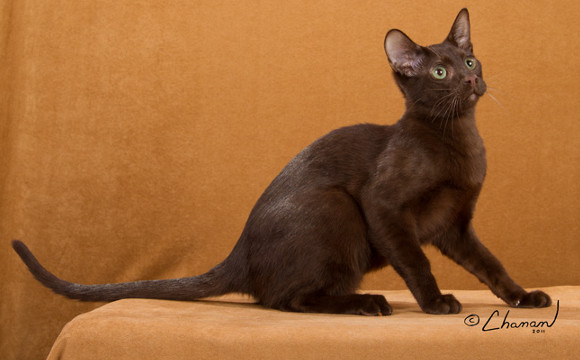
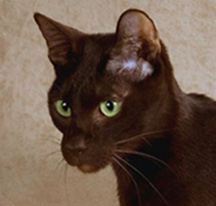
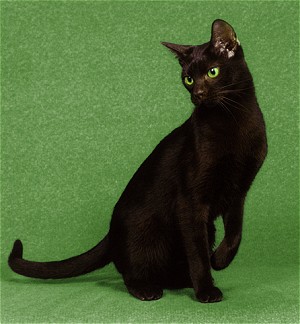
 Animalia Life
Animalia Life